Laser gun engraving has become more than just a trend—it’s a way for owners to express personality and enhance tactical function. Among all customization methods, laser engraving stands out for its precision, versatility, and ability to produce intricate designs with minimal risk to the weapon.
In this article, we’ll explore how laser engraving works on guns and tactical weapons, common techniques, key considerations, and expert tips to help you achieve high-quality, lasting results.
1. What Is Laser Gun Engraving?
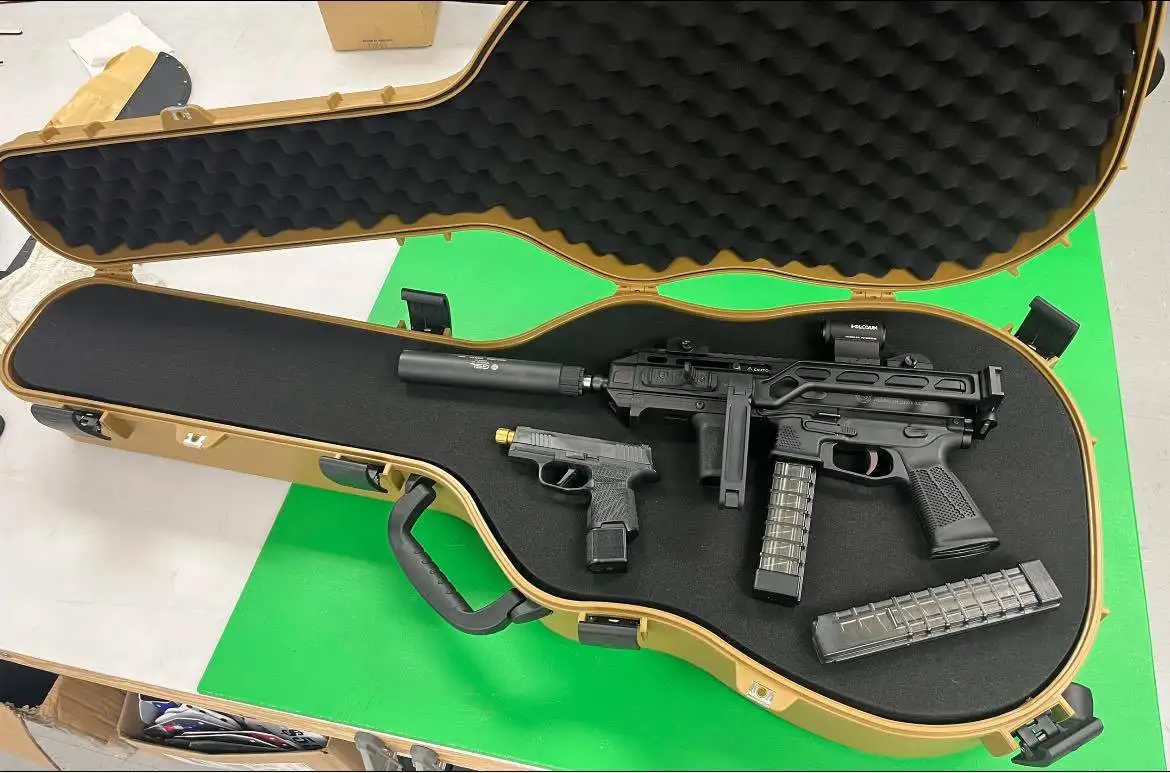
Laser gun engraving is a modern method of engraving firearms or weapons. It uses laser technology. Traditional engraving techniques involve mechanical tools. Laser gun engraving uses focused laser beams. It uses this focused beam for laser engraving a gun. Indeed, laser engraving is a precise & versatile solution for gun engraving.
Laser engraving a gun is almost like that of engraving other objects. A computer controls and directs the laser at the firearm’s surface in laser gun engraving. It removes material to form the desired design. You can adjust the intensity and focus of the laser. Thus, it allows you to achieve varying depths and levels of detail.
Compared to traditional methods, laser engraving offers a wide range of benefits. Laser engraving a gun is quicker, more precise, and can produce intricate details. Indeed, the engraved result can achieve unparalleled accuracy. Moreover, laser engraving a gun minimizes the risk of damaging the firearm. The tools may damage the firearm when working with the mechanical engraving method.
So, these factors ensure the highest quality engraving during the customization process. Laser engraving has many benefits. For this reason, it is a preferred choice for personalized firearm designs.
2. Common Techniques for Laser Engraving a Gun
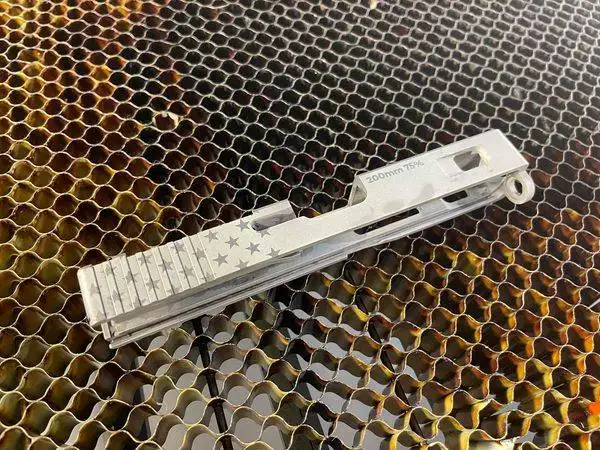
You can engrave almost anything on your weapon using a laser engraving machine. It allows you to showcase your individuality through unique designs. You can engrave logos or quote text on your firearms. From monograms to intricate patterns, the personalization options are diverse. You know, it gives the gun a sense of ownership and identity.
The process begins with calibrating the laser gun and the machine parameters. You can adjust the laser parameters on the software based on your desired output. In this case, you can use Lightburn or laser GRBL software. Once the parameters are ready, you can start the engraving process. , the laser engraver will remove material from the object.
There are three significant techniques of laser engraving a gun.
1. Using the X-Y table technique, We place the gun on a movable table. This table controls the laser’s position on the firearm’s surface. This method is ideal for flat or curved surfaces.
2. The cylindrical model technique is ideal for guns with cylindrical surfaces. In this method, the firearm rotates, and the laser beam engraves the weapon.
3. Both the gun and the laser are stationary methods. A robotic arm moves the firearm to achieve the desired engraving. This technique is suitable for specific designs and larger firearms.
3. Key Considerations for Laser Engraving a Gun
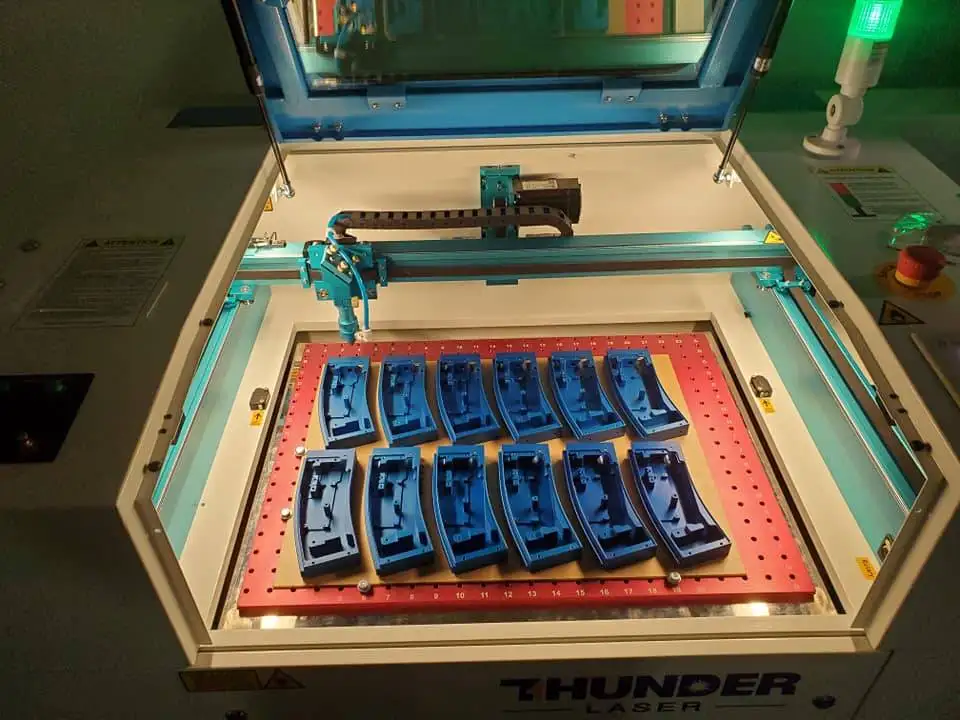
Laser gun engraving can be messy if you consider a few crucial factors. Also, to get the best results, you must consider various parameters. Consider them to assure accuracy, longevity, and safety.
3.1 Legal Considerations for Laser Engraving Firearms
We have seen endless reasons why you don’t ‘have’ to have one and many ways to work around having one, but why? Why take the chance of splitting legal hairs with the federal government? Laws could be more precise. They are only sometimes sure.
If you laser engrave firearms for personal use or as a hobbyist, it may not be an FFL.
3.2 Material Selection for Laser Engraving
In laser engraving a gun, material consideration is the most crucial step. Firearms may come with various materials. Each material presents unique challenges and opportunities for laser engraving. Steel, aluminum, and polymer plastics are noteworthy materials. Thus, understanding the material composition is essential for selecting appropriate laser engraving techniques.
The choice of laser engraver also depends on the type of material. A CO2 laser engraver is the preferred option for plastics. , a fiber laser engraver is more effective when working with metals. This dual method highlights matching engraving to material qualities.
3.3 Customization Possibilities
Laser gun engraving offers a wide array of customization possibilities. The advanced design software allows designers to create personalized patterns, logos, or text. You can use Lightburn software for more features and functionalities. Read our article “Lightburn vs. laser GRBL” for more information about their suitability.
Design software opens up a wide array of creative options. There are practical considerations, too. Check for material hardness, engraving depth, and the laser’s precision. These factors may pose challenges to the final quality of the engraving. Always seek professional help to deal with these difficulties.
Read More: Lightburn vs. laser GRBL
3.4 Tactical Applications
How? Laser engraving a gun gives you a better grip. As a result, it increases weapon retention and control during critical situations. Also, laser-engraved weapons offer quick identification or create textured surfaces.
The tactical applications of laser engraving extend the functionality of weapons. It meets the practical demands of military and law enforcement experts.
3.5 Precision and Detailing in Laser Engraving
Laser engraving is known for its excellent precision and detailing capabilities. Laser technology allows for the creation of intricate designs and fine lines. You know this can be challenging for mechanical engraving methods. This precision is particularly necessary when engraving small or complex areas of firearms. Typical parts include the gun grip or trigger guard.
The engraved designs not only transform a plain gun into a work of art but also prove a unique appearance.
3.6 Safety Measures
Laser engraving involves working with high-power laser beams. They can harm physical objects. During the laser engraving of a gun, the safety measures are considered twice. You must wear protective gear such as safety glasses and gloves to safeguard your eyes & hands. About DIY projects, ensure you have enough knowledge of operating the device.
Moreover, ventilation and workspace safety are also critical factors. Note that adequate ventilation helps disperse fumes and particulate matter produced during engraving. In this case, you can install a proper exhaust system to ensure ventilation. You know it minimizes the risk of inhalation exposure. Finally, to prevent accidents, always ensure a clutter-free workspace.
3.7 Maintenance and Longevity
Proper maintenance of your machine ensures a seamless laser engraving operation. As a result, you can ensure the desired outcome from the laser device. Regular cleaning and routine checks are essential to prevent debris buildup. Also proper lubrication is also necessary for moving parts. Moreover, calibration checks in routine maintenance guarantee optimal functionality.
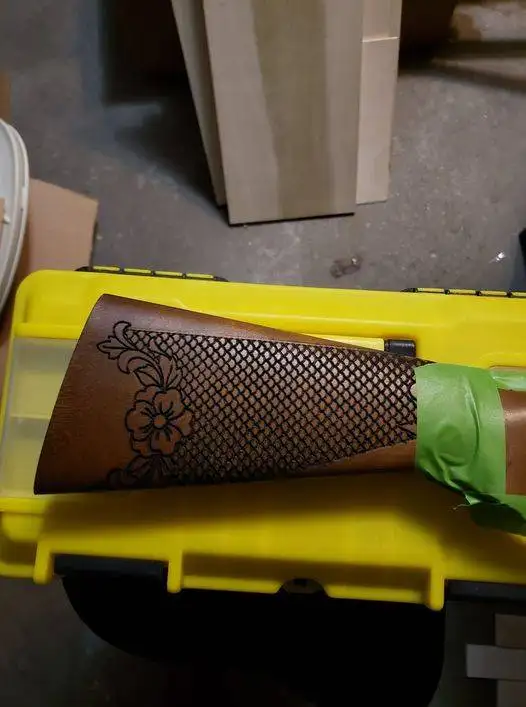
4. Choosing The Right Laser Engraver for a Gun
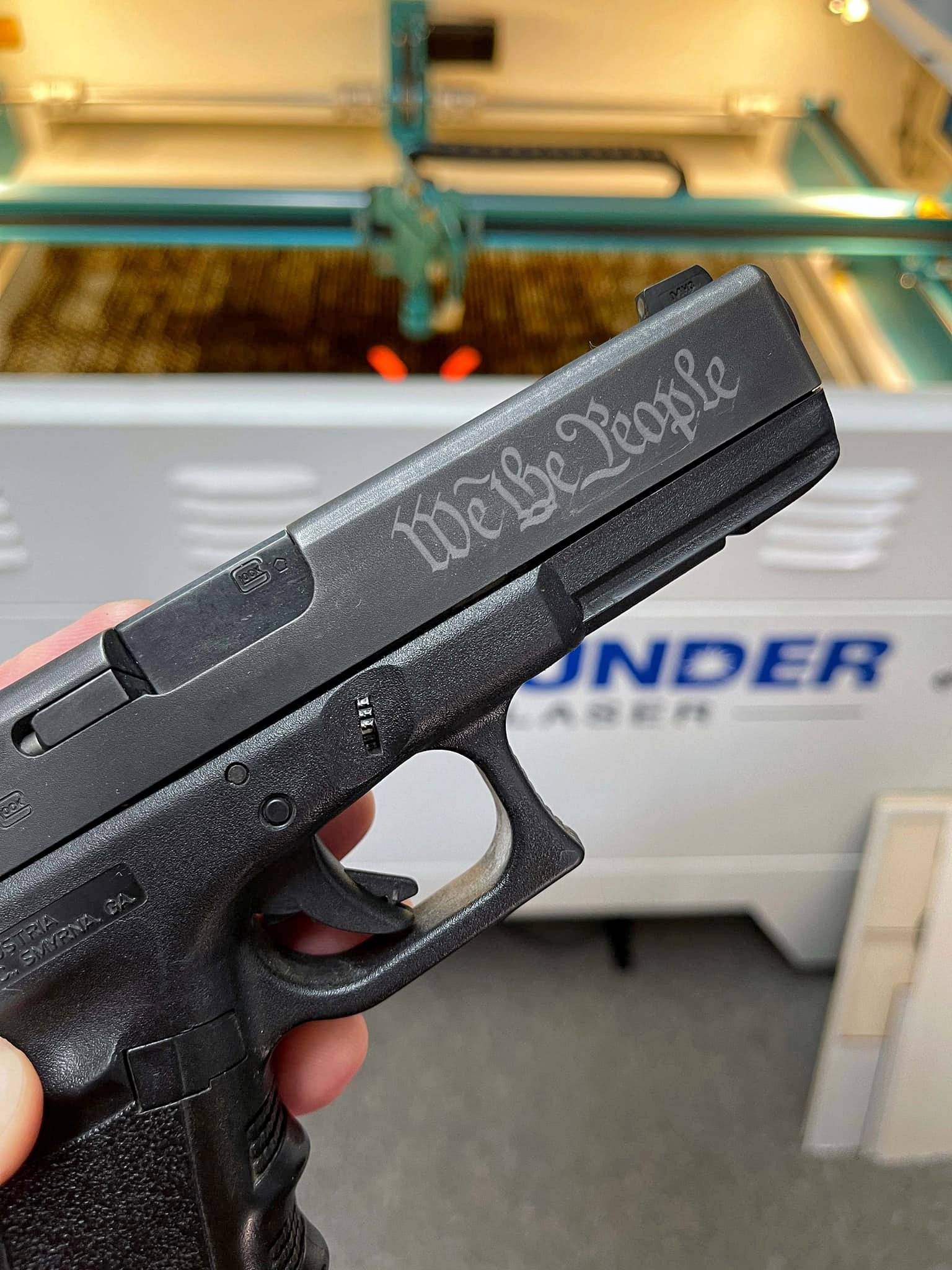
Laser engraving firearms and tactical gear requires not only precision but also compatibility with a variety of materials. Since different parts of a weapon—such as the frame, barrel, or grip—are made from different substrates, selecting the right laser system is essential for clean, lasting results.
For metal surfaces like steel or aluminum, which are commonly used in gun barrels, slides, and receivers, fiber lasers are the preferred option due to their high energy density and ability to create detailed, permanent markings. Thunder Laser Aurora series, equipped with fiber laser technology, is well-suited for these tasks. It provides excellent control for deep engraving, serialization, or applying intricate custom patterns, while maintaining the material’s integrity.
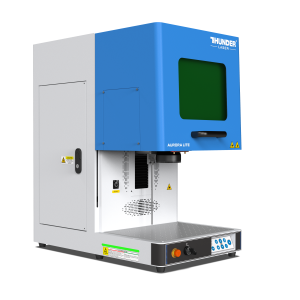
When working with non-metal components, such as polymer grips, wooden handles, or leather accessories, CO₂ lasers are more appropriate. These materials respond better to CO₂ wavelengths, making the Thunder Laser Bolt series a good option. Compact yet powerful, Bolt machines are ideal for personalizing add-ons or engraving logos, names, and decorative elements on softer surfaces with precision and minimal material distortion.
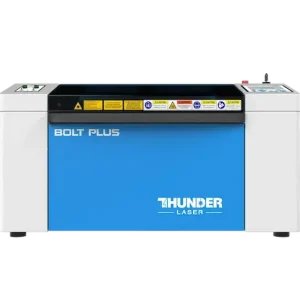
In essence, Aurora series excels in marking metals with fine detail and durability, while Bolt series offers versatility for softer, non-metallic parts. Both series support common design software and allow users to adjust parameters like speed, power, and focus to suit each material and design.
Conclusion
From adding a personal logo to improving grip with textured patterns, laser engraving offers a unique blend of style and functionality for firearms. By understanding material compatibility, choosing the right laser engraver, and following safety protocols, you can create customized weapons that are both visually striking and practical in use.
Whether for personal expression, tactical identification, or collector appeal, laser gun engraving delivers exceptional results that truly stand out.
FAQs About Laser Engraving a Gun
Q1. Can I laser engrave a gun barrel?
Yes, gun barrels can be laser engraved. Laser technology allows for precise and detailed markings on plastic or metals. But, it’s essential to use the correct laser settings and techniques. It can help you avoid affecting the structural integrity of the barrel. It can also help you avoid compromising its performance.
Q2. Do I need a fiber or CO₂ laser engraver for guns?
For metal parts of guns, a fiber laser engraver is recommended. If you’re engraving polymer or plastic components, a CO₂ laser engraver works better.
Q3. Will laser engraving wear off over time on a gun?
No, laser engraving creates permanent marks by altering the surface layer of the material. It’s highly durable, even under heavy firearm use.
Q4. How much does laser engraving a gun cost?
The cost of laser engraving a gun varies based on the complexity of the design and type of firearm. It may also depend on the engraving service provider. On average, this price may range from $15 to $50. Simple designs and engravings cost approximately $25. However, custom designs or extensive detailing may incur more charges.
Q5. How long does it take to laser engrave a gun?
Laser engraving time depends on the design complexity, engraving depth, and the material, but most laser engraving jobs on guns take between a few minutes to an hour.


.png) International
International
 United States
United States
 Brasil
Brasil
 Canada
Canada
 Costa Rica
Costa Rica
 Česká
Česká
 Ελλάδα
Ελλάδα
 Polska
Polska
 Ireland
Ireland
 Portugal
Portugal
 Lietuva
Lietuva
 Россия
Россия Deutschland
Deutschland
 Britain
Britain
 Україна
Україна
 France
France
 Sverige
Sverige
 Italia
Italia
 Norway
Norway
 Denmark
Denmark
 Romania
Romania
 한국
한국
 中国
中国
 ประเทศไทย
ประเทศไทย
 中国香港
中国香港
 Israel
Israel
 中國臺灣
中國臺灣
 India
India
 پاکستان
پاکستان
 پශ්රී ලංකා
پශ්රී ලංකා
 ジャパン
ジャパン
 Australia
Australia
 New Zealand
New Zealand
 South Africa
South Africa